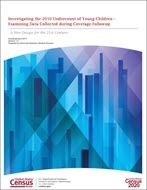
An official website of the United States government
Here’s how you know
Official websites use .gov
A .gov website belongs to an official government organization in the United States.
Secure .gov websites use HTTPS
A lock (
) or https:// means you’ve safely connected to the .gov website. Share sensitive information only on official, secure websites.
-
//
- Census.gov /
- Planning the Count /
- 2020 Census Final Analysis Reports /
- 2010 Undercount of Young Children – Examining Coverage Followup
Investigating the 2010 Undercount of Young Children – Examining Data Collected During Coverage Followup
Investigating the 2010 Undercount of Young Children – Examining Data Collected During Coverage Followup
Introduction
The Census Bureau acknowledges the long-standing undercount of children under the age of 5 in decennial censuses and in Census Bureau surveys. Demographers have documented the high undercount of these youngest children (e.g., West & Robinson 1999, O’Hare 2015). Evaluations show that Census Bureau surveys like the American Community Survey (ACS), the Current Population Survey, and the Survey of Income and Program Participation also undercount young children, which can result in biased survey estimates (O’Hare & Jensen 2014).
In this report, we define “young children” as children age 0 to 4. After the 2010 Census, Demographic Analysis estimated a net undercount of about 4.6 percent for young children (Hogan et al. 2013). This translated into a net undercount of almost 1 million young children. O’Hare (2015) shows that the net undercount rates for young children increased from 1.4 percent in 1980 to 4.6 percent in 2010, while the net undercount rate for the adult population (age 18+) went from an undercount of 1.4 percent in 1980 to an overcount of 0.7 percent in 2010. The rapid rise in the undercount of young children underscores the importance of examining this coverage problem in greater detail.
In 2014, the Census Bureau released a task force report summarizing this issue and recommending research to better understand the possible causes for this undercount (U.S. Census Bureau 2014). An interdivisional team is currently working on several projects that review existing data sources that might provide insights into the high undercount of young children in the 2010 Census.
The 2010 Census included a coverage improvement operation (Coverage Followup or CFU) to improve the accuracy of the household members listed on census questionnaires. Households with suspected coverage errors flowed into CFU. During the CFU operation, interviewers recontacted households by telephone, probing to determine if the list of household members was incomplete or if some people might be included in error. Data from the CFU operation allow us to profile the characteristics of households that initially erroneously excluded young children that CFU successfully added. The CFU data also allow us to study the characteristics of the households that initially indicated that they might have omitted a child, regardless of the outcome of CFU. In combination, they provide important information about households and children that the census may enumerate incompletely.
This is one of two CFU reports. It analyzes the characteristics of the young children that respondents initially omitted from their census questionnaires that CFU determined were missing and later added. The summaries identify instances where respondents made errors that CFU was able to correct. A second report looks at the larger universe of households that responded positively to one of the coverage probes about young children. That report will supplement these findings by assessing if the households with uncertainty about whom to include on their census forms are similar to the households where CFU added young children.
Share
Some content on this site is available in several different electronic formats. Some of the files may require a plug-in or additional software to view.
 Yes
Yes
 No
NoComments or suggestions?


Top

